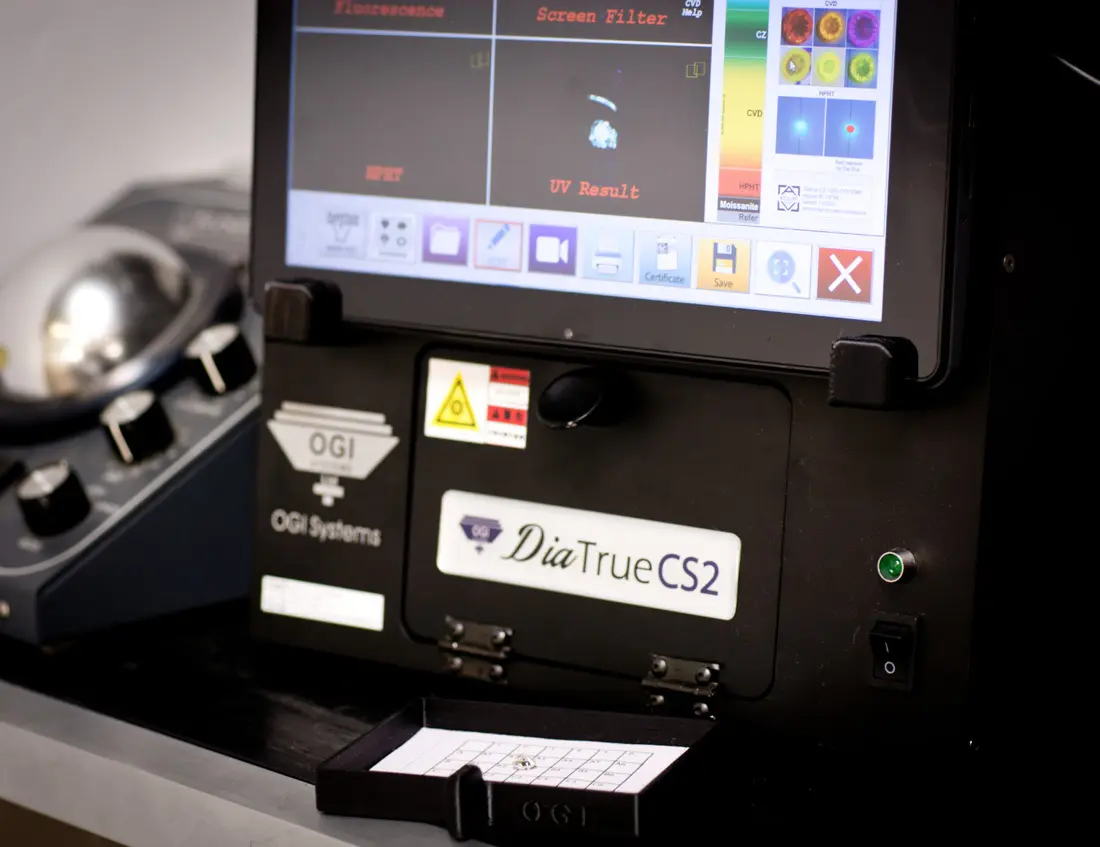
Yes, lab-grown diamonds pass a diamond tester because they are identical to natural diamonds in chemical, physical, and optical properties.
In recent years, the popularity of lab-grown diamonds has been on the rise, and rightly so. This is prominently due to the sustainable and ethical practices used in its production compared to its natural counterpart.
As the diamond industry continues to grow and the demand for lab-grown becomes widespread, it becomes essential for both buyers and sellers to differentiate between natural and lab made diamonds.
And one of the most commonly used tools to identify and tell the difference is a diamond tester.
How Does A Diamond Tester Work?
Primarily, the two modes for testing diamonds are –
- Thermal Conductivity Tests
- Electrical Conductivity Tests
As complicated as it may sound, a diamond tester looks more like an ink pen with a metal tip. A panel on the other end of the diamond tester with a series of colors and light indicates whether the tested stone is a real diamond or other material such as diamond simulant, metal, moissanite, cubic zirconia, etc.
In both the thermal and electrical conductivity tests, the heat is passed through the stone to understand how well the stone can conduct heat. The lab-grown diamonds will show results similar to a natural diamond in both tests.
So, the answer to the question – do lab grown diamonds pass the test? Is Yes!
However, there is a small catch here. The natural diamonds contain traces of nitrogen from growing within Earth’s mantle over millions of years.
The lab-grown diamonds created using a diamond slice don’t necessarily carry traces of nitrogen. So, if the diamond test only looks for nitrogen traces as verification, the lab-grown diamonds would fail.
However, this does not imply that the lab grown diamonds are fake. Irrespective of the outcome of the test, it’s important to remember that lab-grown diamonds are chemically, optically, and physically identical to earth-mined diamonds.
Can A Jeweler Identify A Lab Grown Diamond?
Lab created diamonds look identical to natural diamonds and have the same chemical properties. Depending on the size of the lab-grown diamonds, it can take over a month to create one lab-grown diamond.
For a jeweler, it’s easy to tell that a diamond is a lab-created diamond due to the microscopic inscriptions in it. The lack of nitrogen in lab-grown diamonds is also one of the identifiers of lab-grown diamonds.
It’s important to remember that telling the difference between natural and lab-grown diamonds is impossible for the naked eye.
How To Tell If The Diamond Is Lab-Created?
There are three primary ways to decipher if the diamond is lab-grown.
Firstly, check the certificate that comes with the diamonds. The certificate by the grading lab always mentions the origin. In the case of lab-grown diamonds, it mentions that the diamond is lab-created.
Secondly, check the girdle of the diamond, as there’s always an engraved serial number. If the diamond is lab-grown, it is also specifically engraved next to the serial number.
Lastly, you can identify if the diamond in question is natural or lab-grown by sending it to a certified gemological lab.
The laboratories used advanced machinery and equipment to check the diamond’s nitrogen levels and how it reacts under UV rays to determine whether it is natural or lab-grown.
Signs of Lab-Grown Diamonds
Most of the characteristics of lab-grown diamonds are similar to those of Earth-mined diamonds, including their optical, chemical, and physical properties.
However, there are certain signs that give away that the diamond is lab-created, including features like distinct fluorescence, metal inclusion, microscopic inscriptions, and laser inscriptions.
It is not possible for an untrained eye to tell the difference between real and lab grown diamond rings. It requires trained professionals and the use of advanced testing tools and methods to differentiate lab-grown diamonds from natural diamonds.
FAQs
1. Do Lab Diamonds Pass The Diamond Tester?
Answer – Yes, absolutely! As both natural and lab-grown diamonds are similar in physical, optical, and chemical makeup, they pass thermal and electrical conductivity tests.
However, lab grown diamonds may show different results than the Earth-mined diamonds when specifically checking the nitrogen levels.
2. Are Lab-Created Diamonds Real Diamonds?
Answer – Yes, lab-grown diamonds are real diamonds for all intents and purposes.
3. Is Appraisal Needed For A Lab Grown Diamond?
Answer – If you plan to sell or insure your diamond, you must get an appraisal for your lab-grown diamond. It will help decipher the retail cost of your lab grown diamond.
4. Are Lab-Grown Diamonds As Hard As Real Diamonds?
Answer – On the Mohs Hardness Scale, the natural and lab-grown diamonds score a perfect 10. This is another reason why lab-grown diamonds are increasingly used in everyday jewelry.





 My Account
My Account  My Bag
My Bag  My Wishlist
My Wishlist 
